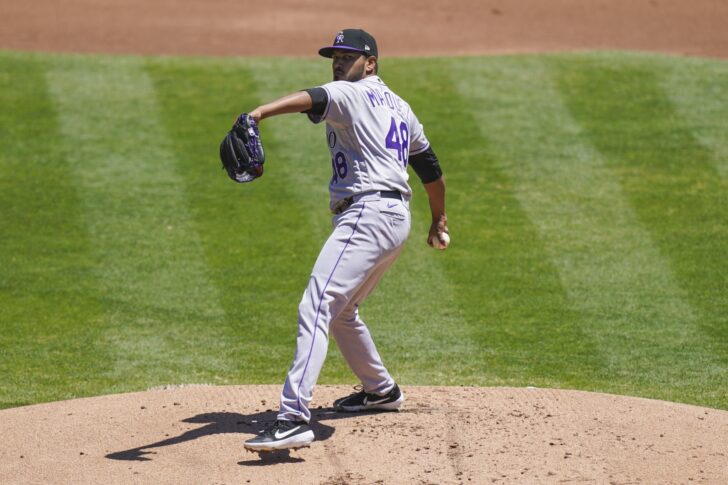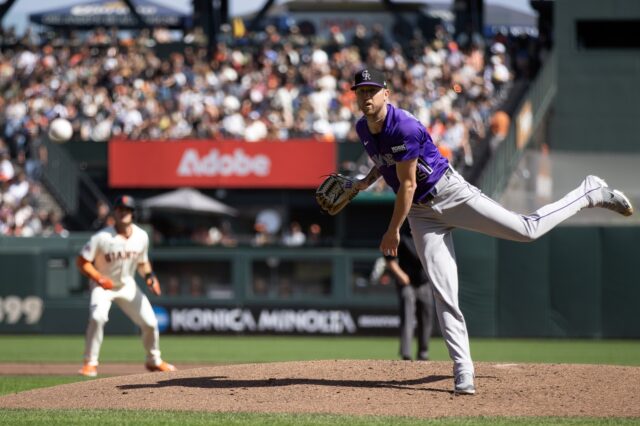The 2020 Colorado Rockies are off to a tremendous start in terms of pitching, ranking second in baseball—behind only Cleveland—with a 1.84 ERA through the first week of the season en route to a 4-1 start heading into their home opener against the San Diego Padres on Friday. The Rockies’ bullpen has been especially stingy, posting a 1.08 ERA that ranks third in the majors. But the starting rotation has been good, too; the unit’s 2.30 ERA is baseball’s fourth best. You get the point; Colorado’s hurlers are on a roll.
But, as is often the case in baseball, immediate results that include small sample sizes often don’t tell the complete story, nor are they always a good indicator of what will happen in the future. And, because of that fact that the Rockies’ terrific start on the mound is fairly unprecedented for the franchise, it’s fair to wonder how sustainable it actually is.
To be clear, there probably isn’t a whole lot of people who think that the Rockies will finish the season with a 1.84 ERA. Of course there will be some regression. The question is, how much? Will the 2020 Rockies at least continue to pitch at a level becoming of a playoff-caliber team, or are they going to fall completely off a cliff? Taking a deeper look into some of the underlying numbers that best contextualize pitching performance and comparing those to statistics from recent seasons can help us determine what to expect going forward.
Pitchers are usually ahead of hitters early in the season, as Fangraphs’ Craig Edwards recently detailed, and despite—or, maybe, because of—the unique circumstances surrounding the beginning of this campaign, 2020 is no different. Edwards surmises that hitters, to this point in the season, are making contact less often than they have over the last three years, and that can be attributed to pitchers being in midseason form in terms of velocity while hitters are still trying to get comfortable at the plate.
There are several other factors to review in order to see how the Rockies are doing, as well. Examining a few of the metrics Edwards compared plus looking at home runs per fly ball and hard-hit rate, stats that are usually particularly relevant for the Rockies, paints somewhat of a grim picture regarding whether Colorado will be able to build upon its stellar first week.
First and foremost, the Rockies will not be able to maintain allowing home runs on just 4.8 percent of fly balls. Though their worse-than-usual performance in that category last season can partially be attributed to a league-wide increase in HR/FB, the Rockies are regularly affected by elevated home run rates because of—I know, sorry—Coors Field. There’s little reason to expect that to be different this year, unless the lack of fans in attendance somehow helps the ball stay in the park.
It’s also interesting that Rockies pitchers have evidently become so poor at inducing infield fly balls. There was a sharp decrease last season that has continued into 2020 despite the league IFFB% going down only slightly. That may not have a huge effect on the overall results when it’s all said and done, but the same might not be able to be said about batting average on balls in play and hard-hit rate. Even if all of the other numbers already mentioned miraculously stayed the same, the Rockies would still take a hit because of what is usually a correlation between BABIP and how hard pitches are hit. Right now, Colorado pitchers are actually yielding harder contact than they normally do, but a mix of good defense and a high concentration of “at ‘em balls” have kept the opponents’ batting average down. Regardless of what happens with home run, grounder, and infield fly rates, that .244 BABIP is going to trend upward—and soon.
None of this is to say, of course, that the Rockies’ pitching staff can’t be marginally—or, even, significantly—better than it was last season. The bullpen is loaded with pitchers who have above-average velocity and at least decent command. That wasn’t the case last season, when the likes of Jake McGee, Bryan Shaw, Chad Bettis, and Mike Dunn were relied upon to eat up a ton of innings. As we’ve already devoted a ton of ink to explaining in previous articles, innings will be at a premium this season, and the usual wear and tear accumulated by the Rockies’ bullpen as a result of the unique challenges presented by pitching in Coors Field half of the time shouldn’t be an issue in 2020. Plus, Germán Márquez is a bona fide ace at the front of the rotation, as evidenced by the significant improvement he’s shown during his time as a major leaguer. And the rest of the starting staff isn’t bad, either. We’ve seen that time and time again during the Rockies’ current window as a competitive club.
However, don’t expect Colorado’s pitching to continue at a record pace. The schedule will get tougher, the hitters will get better, and the loud outs will start turning into hits. Fortunately, the same can be said about the Rockies’ offense. Nolan Arenado and Charlie Blackmon aren’t going to have sub-.600 OPSs for long, and at some point, someone on the team is going to have a batting average of .300 or better. The key for the Rockies is to continue to capitalize on the solid performance of the pitching staff while it lasts, and get to as many games above .500 as they can. They’ve done a great job of that so far and, as you can tell, there’s something a little different in the air in 2020.




